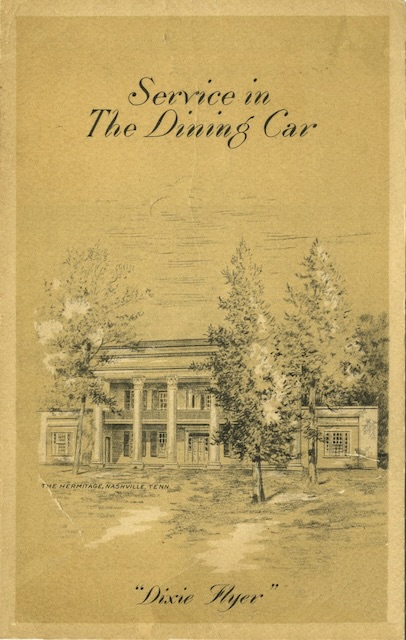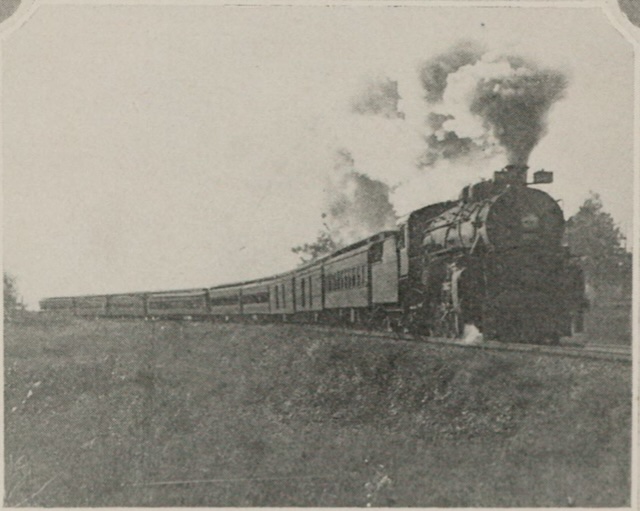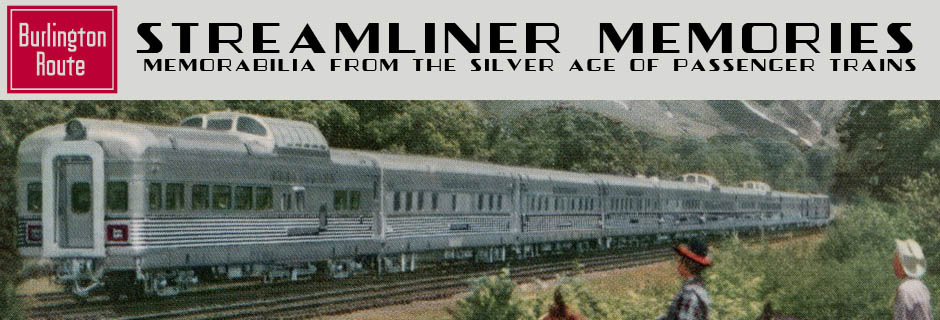Wikipedia says that “supper” usually refers to the “main evening meal” or a “light snack or meal in the evening” while lunch is “eaten around the middle of the day.” So what time of was this menu, which says “supper” on the main menu but “luncheon” on the insert, offered to passengers?
 Click image to download a 970-KB PDF of this menu.
Click image to download a 970-KB PDF of this menu.
This is not an accidental mix-up of two menus, as the insert is glued onto the main menu. Nor is the insert a table d’hôte menu while the main menu is a la carte; in fact, both are a la carte. The insert is labeled “special today” even though many of the items on it are also on the main menu, usually for the same price.
The main menu has a drawing of the Hermitage, Andrew Jackson’s home, on the front cover. It offered oysters raw (30¢), fried (40¢), or stewed (30¢ in milk, 50¢ in cream); three sizes of sirloin steak (75¢, $1, and $1.75); and half a chicken, fried or broiled (65¢).
The insert is decorated with an engraving of a waiter bringing a meal to a properly dressed man and woman seated in a dining car. It offered such items as fried Tennessee rabbit for 50¢ and roast Tennessee turkey for 65¢. Items on both menus include chow chow pickles (15¢), lake trout with tartar sauce (60¢), lima beans (15¢), and Hawaiian pineapple (or “pine apple” on the insert; 25¢).
The menu is undated but based on the prices I would say it is from between 1910 and 1917. It is not from during or after the Great War. It could be from a few years before 1910 but it is almost certainly post-1900. Assuming 1910 is correct, multiply prices by about 35 to get today’s dollars.
The history of the Dixie Flyer goes back to 1890, when the Nashville, Chattanooga & St. Louis Railroad leased the Western & Atlantic Railroad, giving it a connection from Chattanooga to Atlanta. This gave the railroad’s passenger agent, W.L. Danley, the idea of running a train from Nashville to Jacksonville. From Atlanta to Macon the train would run on the Central of Georgia; from Macon to Tifton it would run on the Georgia Southern & Florida Railway; and from Tifton to Jacksonville it would run on the Atlantic Coast Line.
By 1904 the train had been extended to Chicago over the Chicago & Eastern Illinois to Terre Haute; the Evansville & Terre Haute between those two cities; and the Louisville & Nashville railroad (which owned a controlling interest in the) from Evansville to Nashville. A section of the train also went to St. Louis over the Illinois Central.
Thus, nine different railroads were involved in the operation of this one train. However, several were financially related to one another: in 1880 the Louisville & Nashville acquired a controlling interest in the Nashville, Chattanooga & St. Louis while in 1902 the Atlantic Coast Line gained a controlling interest in the Louisville & Nashville. The Evansville and Terre Haute was controlled by the Chicago & Eastern Illinois. Also, after 1907 the Illinois Central owned a controlling interest in the Central of Georgia. For what it’s worth, the Georgia Southern & Florida was controlled by the Southern Railway while the Chicago & Eastern Illinois was controlled by the Frisco. So financially there were four groups of railroads involved in the train while operationally there were seven.
 The Dixie Flyer became an all-Pullman train in November 1924. This publicity photo was taken shortly before that. Click image for a larger view.
The Dixie Flyer became an all-Pullman train in November 1924. This publicity photo was taken shortly before that. Click image for a larger view.
The 1911 Official Guide says that the train consisted of a baggage car, a mail car, “high-back-seated comfortable coaches,” a dining car between Evansville and Atlanta, two 12-section, one drawing room sleeping cars, and a compartment-observation car, plus at least one sleeping car from St. Louis. The above image, which was taken in 1924 on the NC&StL, shows a similar consist but with a coach in front of the baggage cars. That coach would have been for “colored people.”
The back of the menu says it was printed by the Brandau-Craig-Dickerson Co. in Nashville. I’m associating it with the Nashville, Chattanooga & St. Louis as the L&N would have printed its menus, if they were different, in Louisville.
This menu was collected by the late William Edward Trierweiler and was donated to Streamliner Memories by his son, Edward Trierweiler. We greatly appreciate the contribution.
